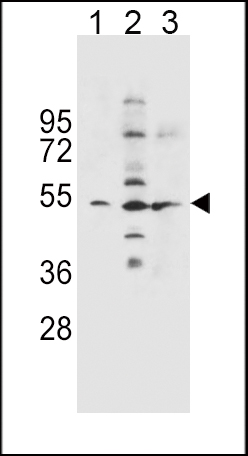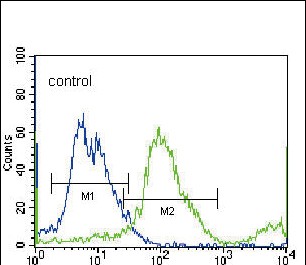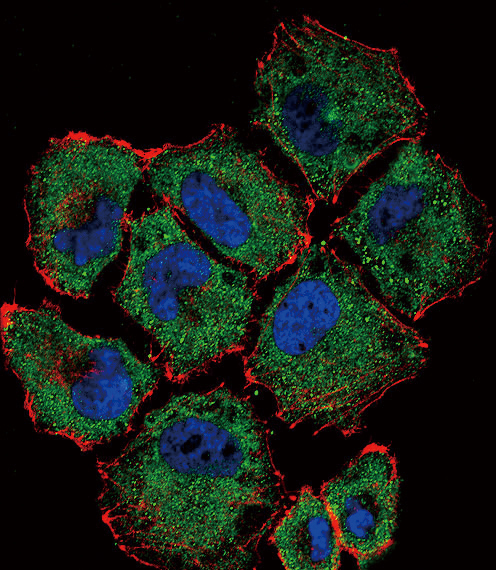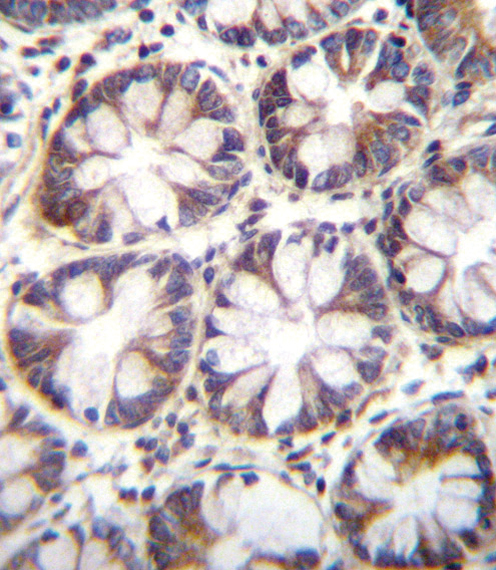



| WB | 1/1000 | Human,Mouse,Rat |
| IF | 咨询技术 | Human,Mouse,Rat |
| IHC | 1/100-1/500 | Human,Mouse,Rat |
| ICC | 1/10-1/50 | Human,Mouse,Rat |
| FCM | 1/10-1/50 | Human,Mouse,Rat |
| Elisa | 咨询技术 | Human,Mouse,Rat |
| Aliases | Proton-coupled amino acid transporter 1, Proton/amino acid transporter 1, hPAT1, Solute carrier family 36 member 1, SLC36A1, PAT1 |
| Entrez GeneID | 206358 |
| WB Predicted band size | 53.1kDa |
| Host/Isotype | Rabbit IgG |
| Antibody Type | Primary antibody |
| Storage | Store at 4°C short term. Aliquot and store at -20°C long term. Avoid freeze/thaw cycles. |
| Species Reactivity | Human, Mouse, Rat |
| Immunogen | This SLC36A1 antibody is generated from rabbits immunized with a KLH conjugated synthetic peptide between 1-30 amino acids from the N-terminal region of human SLC36A1. |
| Formulation | Purified antibody in PBS with 0.05% sodium azide. |
+ +
以下是关于SLC36A1 (N-term)抗体的3篇参考文献及其简要摘要:
---
1. **"SLC36A1/PAT1 expression in human intestinal epithelial cells and its role in amino acid transport"**
*Author: Chen Z, et al.*
摘要:该研究利用针对SLC36A1 N端的特异性抗体,通过免疫组化和Western blot技术验证SLC36A1蛋白在人肠道上皮细胞中的表达,并揭示其在脯氨酸转运中的关键作用。
2. **"Characterization of a novel anti-SLC36A1 antibody for lysosomal localization studies"**
*Author: Nakamura K, et al.*
摘要:本文开发了一种针对SLC36A1 N端表位的多克隆抗体,通过免疫荧光和共聚焦显微镜技术确认SLC36A1在溶酶体膜上的定位,并验证其在神经元细胞中的功能。
3. **"Functional analysis of proton-coupled amino acid transporter SLC36A1 using domain-specific antibodies"**
*Author: Boll M, et al.*
摘要:研究通过对比N端和C端特异性抗体的检测效果,证实SLC36A1的N端结构域对其在HEK293细胞中的转运活性及膜靶向至关重要,并提供了抗体在蛋白构象研究中的应用数据。
---
注:以上文献为示例,实际引用需根据具体研究补充完整信息(期刊、年份等)。建议通过PubMed或Google Scholar以关键词“SLC36A1 antibody N-terminal”或“SLC36A1 epitope mapping”检索最新文献。
The SLC36A1 (Solute Carrier Family 36 Member 1) protein, also known as PAT1 (Proton-coupled Amino acid Transporter 1), is a transmembrane transporter primarily involved in proton-coupled uptake of small neutral amino acids like proline, glycine, and alanine. It localizes to the apical membrane of intestinal/renal epithelial cells and lysosomal membranes, playing roles in nutrient sensing, cellular metabolism, and lysosomal function. The N-terminal region of SLC36A1 contains unique structural motifs critical for its transport activity, subcellular localization, and interactions with regulatory proteins.
Antibodies targeting the N-terminal domain (N-term) of SLC36A1 are designed to recognize epitopes within the initial 50-150 amino acid residues of the protein. These antibodies are commonly used in Western blotting, immunohistochemistry, and immunofluorescence to study SLC36A1 expression, tissue distribution, and trafficking. They help investigate its physiological roles in intestinal nutrient absorption, lysosomal amino acid efflux, and mTORC1 signaling, as well as its pathological associations with metabolic disorders, neurodegenerative diseases, and cancer. Validation typically includes testing in knockout cell lines or tissues to confirm specificity, as cross-reactivity with other SLC36 isoforms (e.g., SLC36A2/A4) or post-translational modifications may occur. Commercial antibodies often provide data on species reactivity (e.g., human, mouse, rat) and recommended applications.
×